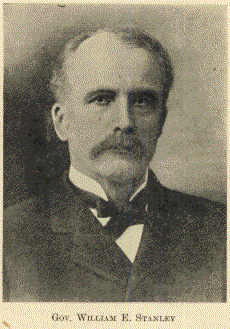| 1918 KANSAS AND KANSANS | Chapter 61 | Part 1 |
CHAPTER LXI
WILLIAM EUGENE STANLEY

[Copy by Willard of Portrait in Library of Kansas State Historical Society]
William Eugene Stanley, fifteenth Governor of Kansas, was born December 28, 1844, in Knox County, Ohio. In 1869 his parents moved to Hardin County, where he was reared to manhood.
Stanley's father was a physician, and a man of good character and much influence in the community. He sent his son through the common schools. Later Stanley entered the Ohio Wesleyan University, at Delaware, Ohio. However, he left this institution before his graduation, and entered the office of Bain & King, at Kenton, where he studied law. Afterwards, he continued his studies in the firm of Conover & Craighead, at Dayton. He was admitted to the bar in 1868.
Two years after he received his diploma he came to Kansas, and located in Jefferson County, where he began the practice of his profession. Soon after settling in Jefferson County he was elected County Attorney.
He located at Wichita in 1872. He served as County Attorney of Sedgwick County three terms. Following his last term as County Attorney, he was elected to the State Legislature. He served one term in that body. An appointment as Judge of the Court of Appeals was tendered to him by Governor Morrill, but this honor he declined.
In 1876 Mr. Stanley was married to Miss Emma L. Hillis, of Wichita, Kansas. Of this union were born three children, two sons and a daughter.
Mr. Stanley followed his law practice industriously, and became well-known to the state at large as an honest, intelligent, hard-working man.
The Republican State Convention which met at Hutchinson in June, 1898, nominated him as the candidate for Governor. He was elected by a large majority. During this administration, marked progress was made in the recovery from the effects of the "boom" of the eighties. Speaking of the spirit of that time, Prentis says:
Governor Leedy had been censured for calling a special session of the Legislature to enact laws to regulate the railroads, through the Court of Visitation. Governor Stanley, while recommending a much more conservative policy and much more leniency towards the railroads, still displayed a firm inclination to support the Leedy measure and give it a fair test. However, a suit to test the validity of the Court resulted in its being declared unconstitutional.
As a measure of economy, Governor Stanley urged on the Legislature the abolition of many useless offices, but no steps were taken by that body along this line. Acts were passed appropriating money to complete the State House, to establish a binding-twine plant at the penitentiary, to create a Traveling Library, Commission, and many other measures demanded by the growing needs of the State.
By the Legislature of 1901, a new Board of Railroad Commissioners was created and their duties defined. An appropriation of $47,000 was made to pay the transportation of the Twentieth Kansas. The good-roads question was agitated, a commission appointed, its powers and duties defined, and a tax levy fixed to meet the expenses.
Joseph R. Burton was elected United States Senator by the Legislature. This body also accepted the Pike-Pawnee Village site as a gift to the State, and appropriated $3,000 to appropriately mark and fence the place.
A strike of the convicts at the penitentiary in 1901 resulted in the killing of two of them and the punishment of the ringleaders. There was also a revolt at the United States prison at Fort Leavenworth, in which twenty-seven convicts escaped. Eighteen of these were killed or captured within a few days.
After retiring from the Governor's office, Mr. Stanley returned to Wichita and resumed his law practice. This profession he continued to follow until his death, which occurred October 13, 1910.
| 1918 Kansas and Kansans | Previous Section | Next Section |
A Standard History of Kansas and Kansans , written and compiled by William E. Connelley, transcribed by Carolyn Ward, 1998.
